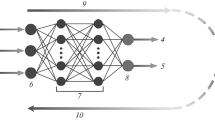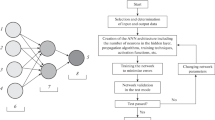Abstract
The purpose of this paper is to predict the compressive residual stress profile induced by the laser shock peening process and to optimize the surface conditions on a Ti-6Al-4V titanium super-alloy using the new technology based on the artificial neural networks. This study covers two principal cases: (i) The numerical analysis: the compressive residual stress distribution induced by the laser peening process is simulated based on the finite element method using ABAQUS software (ABAQUS/Explicit code). (ii) The mathematical modeling analysis: the using of the artificial neural network technique has been proposed to predict the residual stress profile induced by the laser shock processing in order to optimize the laser shock peening surface conditions. To train the artificial neural network, we use different numerical experiments measurements as training and test data. The best fitting training data set was obtained with four neurons in the hidden layers. After training and as seen from the mathematical experiments, the calculated residual stress and the damage state are obviously acceptable. The principal goal of this research paper is to predict the surface treatment state induced by the laser shock peening based on the artificial neural networks technique and on the numerical results without making multiple simulations that can take much more time.
Similar content being viewed by others
References
Gujba AK, Medraj M (2014) Laser peening process and its impact on materials properties in comparison with shot peening and ultrasonic impact peening. Materials 7(12):7925–7974
Frija M, Fathallah R, Hassine T (2010) Finite element prediction of laser shock peened surface modifications in Ti-6Al-4V alloy. Key Engineering Materials 417-418:853–856
Frija M, Ayeb M, Seddik R, Fathallah R, Sidhom H (2018) Optimization of peened-surface laser shock conditions by method of finite element and technique of design of experiments. Int J Adv Manuf Technol 97(1–4):51–69
Ayeb M (2018) Développement d'un modèle de prévision de l'état induit du traitement. Editions universitaires européennes EUE. p 92
Kay G (2003) Failure modeling of titanium 6Al-4V and aluminum 2024-T3 with the Johnson-Cook material model. Office of Aviation Research, Washington, D.C., p 20591
Johnson GR, Cook WH (1983) A constitutive model and data for metals subjected to large strains, high strain rates and high temperatures, Proceedings of the 7th International Symposium on Ballistics 54, pp. 541–547
Smith PR, Shepard MJ, Prevéy III PS, Clauer AH (2000) Effect of power density and pulse repetition on laser shock peening of Ti-6AI-4V. J Mater Eng Perform 9:33–37
Fabbro R, Peyre P, Berthe L, Scherpereel X (December 1998) Physics and applications of laser-shock processing. J Laser Appl 10:265–279
Fang YW, Li YH, He WF, Li PY (2013) Effects of laser shock processing with different parameters and ways on residual stresses fields of a TC4 alloy blade. J Mater Sci Eng 559:683–692
Amarchinta HK, Grandhi RV, Langer K, Strangel DS (2009) Material model validation for laser shock peening process simulation. Model Simul Mater Sci Eng 17:015010–015015
Ghabeche W (2005) Etude par réseaux de neurones de comportement mécanique d’un matériau ductile—application au HDPE—, Faculté des Sciences, Universite Badji Mokhtar Annaba, Algeria, p 55
Frija M, Ben Sghaier R, Bouraoui C, Fathallah R (2012) Optimizing residual stress profile induced by laser shock peening using DOE technique. Appl Mech Mater 146:83–95
Funding
This work is carried out thanks to the support and funding allocated to the Unit of Mechanical and Materials Production Engineering (UGPMM/UR17ES43) by the Tunisian Ministry of Higher Education and Scientific Research.
Author information
Authors and Affiliations
Corresponding author
Rights and permissions
About this article
Cite this article
Ayeb, M., Frija, M. & Fathallah, R. Prediction of residual stress profile and optimization of surface conditions induced by laser shock peening process using artificial neural networks. Int J Adv Manuf Technol 100, 2455–2471 (2019). https://doi.org/10.1007/s00170-018-2883-z
Received:
Accepted:
Published:
Issue Date:
DOI: https://doi.org/10.1007/s00170-018-2883-z




